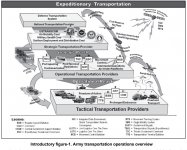We could probably use a 'Lyme Bay' equivalent, to enable amphibious ingress/egress along our own gigantic coastlines if nothing else, which looks alot like some of our Coast Guard ships:
The Royal Navy’s New Assault Ship Is The Royal Navy’s Old Assault Ship
RFA 'Lyme Bay' with a Merlin on her flight deck and Wildcats overhead.
The world’s coasts are getting a lot more dangerous as powers such as Russia and China deploy more and more small, quiet submarines and long-range anti-ship missiles.
In response, rival powers
are reorganizing their fleets. In general, naval leaders aim to spread out their ships across a wider area in order to complicate enemy targeting. They’re also pulling away from hostile shores.
The latter has obvious implications for a traditional naval concept—the amphibious assault.
Where before, a fleet might safely congregate big, slow amphibious ships just a few miles from an enemy’s beaches, today that kind of operation is probably naval suicide. Subs and missiles could make quick work of amphibs—dooming not only their crews, but the hundreds of troops riding inside.
It’s not that amphibious operations are any less important. Navies, however, recognize they need to conduct sea-to-shore assaults from farther away. That can mean relying less on slow-moving, short-range landing craft and more on fast, far-flying rotorcraft.
To that end, the Royal Navy is breaking up its normal amphibious organization. The British fleet for decades has organized its assault ships—today including two
Albion-class landing platforms and three
Bay-class amphibious docks—into an amphibious task group.
Now there’s a new plan—and it could result in an amphibious force with more helicopter capacity. Instead of organizing one big amphibious task group, the Royal Navy by 2023 wants to divide its five amphibs into two so-called “littoral response groups.” One for the Atlantic Ocean and another for the Indian and Pacific Oceans.
“The LRG is part of a broader initiative to adapt the U.K.’s amphibious forces to operate in a more dispersed and agile way in response to the increasingly challenging environments that they are now facing,” the International Institute for Strategic Studies in London
explained.
According to the news website
Navy Lookout, the Pacific LRG—slated for deployment in 2023—could include an
Albion, a
Bay and a frigate. But there’s a problem. None of these ships has a fixed hangar for a large helicopter type such as the fleet’s Merlin.
That’s about to change. The U.K. government’s recent Integrated Review pledged 50 million pounds—around $70 million—to convert one
Bay for the LRG role.
Navy Lookout anticipates the ship in question is
Lyme Bay.
The 580-foot-long
Bays always were prime candidates for an aviation upgrade. The Dutch-designed landing docks, as built in the early 2000s, lack fixed hangars for helicopters.
They instead have flimsy fabric shelters that temporarily can accommodate a pair of small helicopters in the class of the navy’s Wildcat. The
Bays also lack the command facilities they might need for long-range amphibious operations.
It’s not yet clear what changes the Royal Navy will order for
Lyme Bay when the vessel enters the yard for rework, likely sometime next year. But all the likely plans involve adding a fixed hangar for up to three Merlins.
In addition,
Lyme Bay could get additional workstations for command and control plus recreational facilities so the ship better can accommodate up to 350 soldiers, marines and special operations troops for months at a time.
The end result should be an amphibious ship with significantly more aerial capability. That’s good news for British troops hoping to survive their next amphibious assault.
The Royal Navy is breaking up its normal amphibious organization.

www.forbes.com

en.wikipedia.org







